1993 CHEVROLET CORVETTE ECO mode
[x] Cancel search: ECO modePage 30 of 370
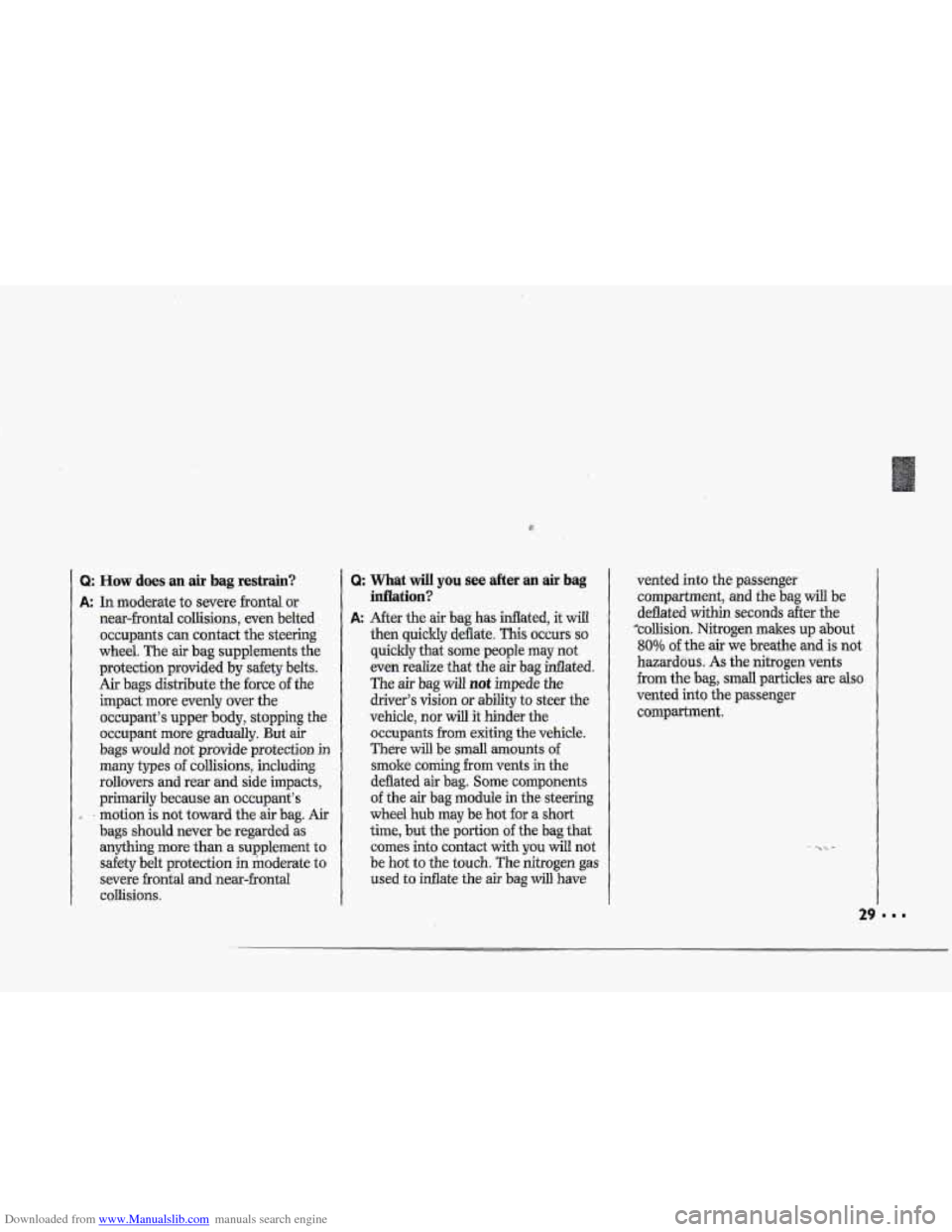
Downloaded from www.Manualslib.com manuals search engine i
Q: How does an air bag restrain?
A: In moderate to severe frontal or
near=frontal collisions, even belted
occupants
can contact the steering
wheel. The air bag supplements the
protection
provided by safety belts.
Air bags distribute the force of the
impact more
evenly over the
occupant's
upper body, stopping the
occupant
more gradually. But air
bags would not provide protection in
many types of collisions; including.
rollovers and rear and side impacts,
primarily because
an occupant's
.: - motion is not toward the air bag. Air
bags should never be regarded as
anything more than a supplement to
safety belt protection in hoderate to
severe frontal
and near-frontal
collisions.
Q: What wiu you see after an air bag
Mation?
A: Mer the air bag has inflated, it will
then quickly
deffate. This occurs so
quickly that some people may not
even realize that the air bag Sated.
The air bag will not impede the
driver's vision
or ability to steer the
vehicle,
nor will it hinder the
occupants from exiting the vehicle.
There
will be small amounts of
smoke
coming from vents in the
deflated
air bag. Some components
of the air bag module in the steering
wheel
hub may be hot for a short
time, but the portion of the bag that
comes into contact
with you will not
be hot to the touch. The nitrogen gas
used to inflate the air bag will have ventdinto
the passenger
compartment, and the
bag will be
deflated within seconds after the
"collision. Nitrogen makes
up about
80% of the air we breathe and is not
hazardous. As the nitrogen vents
from the bag, small particles we also
vented into the passenger
compartment.
29
Page 51 of 370

Downloaded from www.Manualslib.com manuals search engine Features & Controls
Passive Keyless Enfry Safety
Features (CONT.)
If you have your keys and the h.om does
not sound, check to see’if the passive.
feature is.enabled.
If the system is
enabled and the horn still won’t sound,
see your dealer for -assistance.
The transmitter
shuts down after 21
seconds without movement to
maximize battery life. If. you’ve lpclted
your keys in the vehicle, but didn’t leave
them
in the ignition, wait 25 seconds,
then rock the vehicle.
A motion
detector inside the. transmitter
will send
a si-gnal to “wake up’’ the vehicle, which
will then unlock the doors.
It is still possible to lock your lreys in
the vehicle if the transmitter’s battery is
low, or if it is in a location where a
signal
can’t be received, .For your
convenience, a€ways take your keys
with.you.
io
-Matching Transmitter(§) to Your
Vehicle
Your Corvette comes equipped from the
-factory with one Passive
Keyless Entry
system transmitter. Additional
transmitters
may be purchased through
your- dealer. Each Bey chain transmitter
is coded to prevent
another transmitter
from unlocking
your vehicle. If a
transmitter is lost or stolen, a
replacement
can be purchasdthrough
your dealer. Remember to bring the-
remaining. transmitter
(s) with you when
you
go to your dealer. When the dealer
matches the replacement transmitter
to
your vehicle, the remaining
transmitter(s)
must aIso be matched.
‘Once the new transmitter
is coded, the
lost transmitter will not unlock your
vehicle.
Programming Transmiff ers
The Passive Keyless Entry system
allows up to thee transmitters
to be
matched to
your Corvette. Each
transmitter has its
own code. To
operate with your~particular vehicle, the
code needs
to be programmed into the
system.
To Engage the Pmgramming Mode:
1 I Move all transmitters out of range.
2. Turn.the ignition key on.
3. Push the TRIP ODO button on the
Driver Information Center twice.
4. Within five seconds, press and hold
the FUEL INFO button on the
Driver Inforfiation Center until the
PASSIVE KEYLESS ENTRY light
comes on and stays on. --
5. Turn the ignition key to the Off
position, but leave the key in the
ignitiofi..
Page 52 of 370
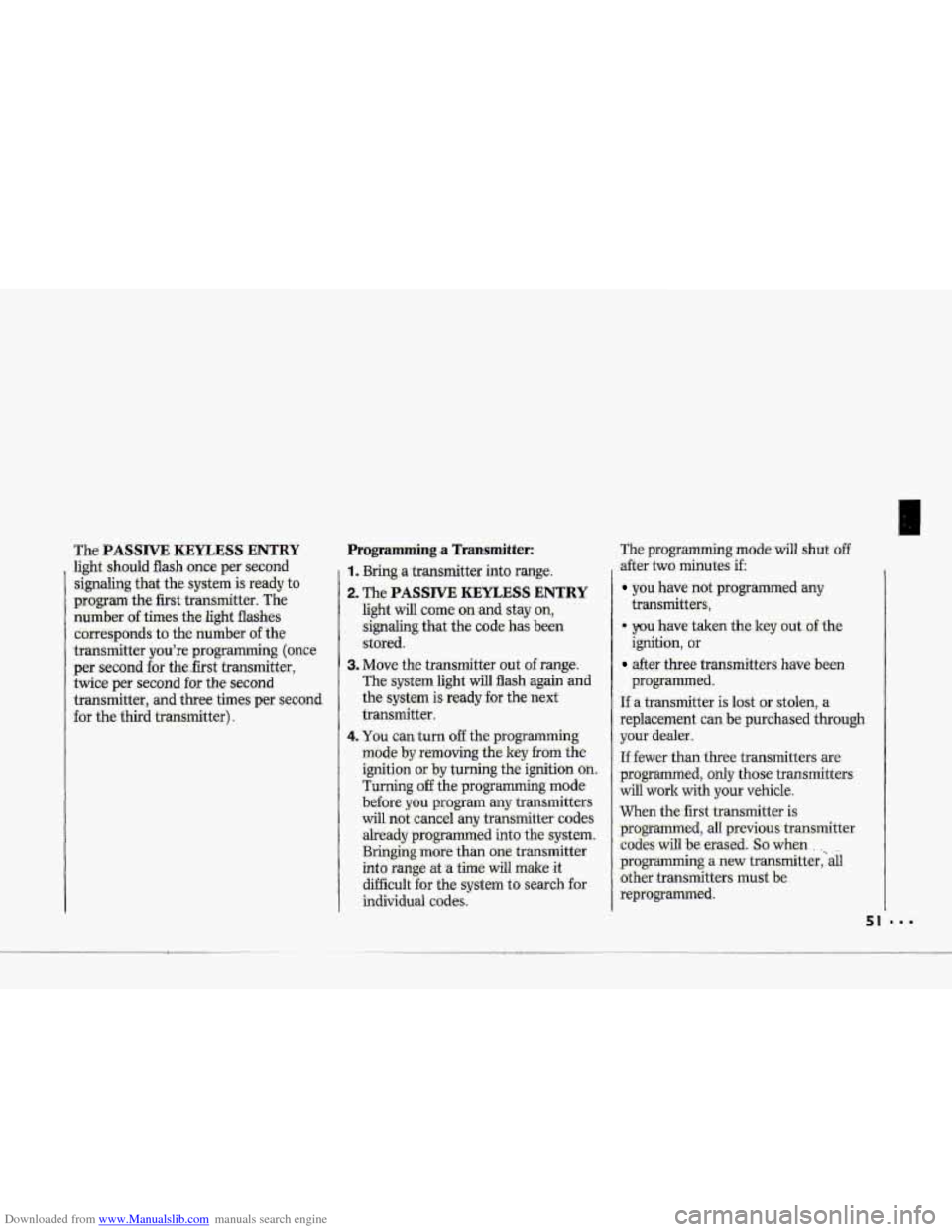
Downloaded from www.Manualslib.com manuals search engine The PASSIVE KEYLESS ENTRY
light should flash once per second
signaling that the system is ready to
program the first transmitter.
The
number of times the light flashes
corresponds to the number ofthe
transmitter you're programming
(once
-per second-for the..first trarrsmitter,
twice per
second for the second
transmitter,
and three times per second
for the- third transmitter).
Programming a Transmitter:
1. Bringa transmitter into range.
2. 'The PASSIVE KEYLESS ENTRY
light will come on-and stay an,
signaling that-the code has been
stored..
3. Move, the transmitter out of range.
The system light will flash again and
the system is ready for the next
transmitter.
4. You can turn of€ the. pograrnming,
node by removing the ley from the
ignitipn or
by turning the ignition on.
Turning uff the programming. mode
before you pro-gram my transmitters
will-not
.cancel-any transmitter codes
akeady programmed into the system.
Bringing
m&e than one transmitter
into
range at :a time will make it
difficult
for the system to search-for
individual
codes.
The program-ming: mode will shut off
after two minutes Z
you have not programed any
-* ~l;ou have taken the key out of the
after three transmitters have been
If a transmitter is lost or stden, a
replacement can be .purchased through
yourdealer.
If .fewer-than three transmitters are
programmed, only those transmitters
will work with your vehicle.
When the.first transmitter is
programmed,
all prev.ious transmitter
codes.,wiU be erased. So when , , ,
pto'grmming a new transmitter,~d
other transmitters must
be
.reprogrammed. transmittegs,
ignition, or
programmed.
SI
Page 141 of 370
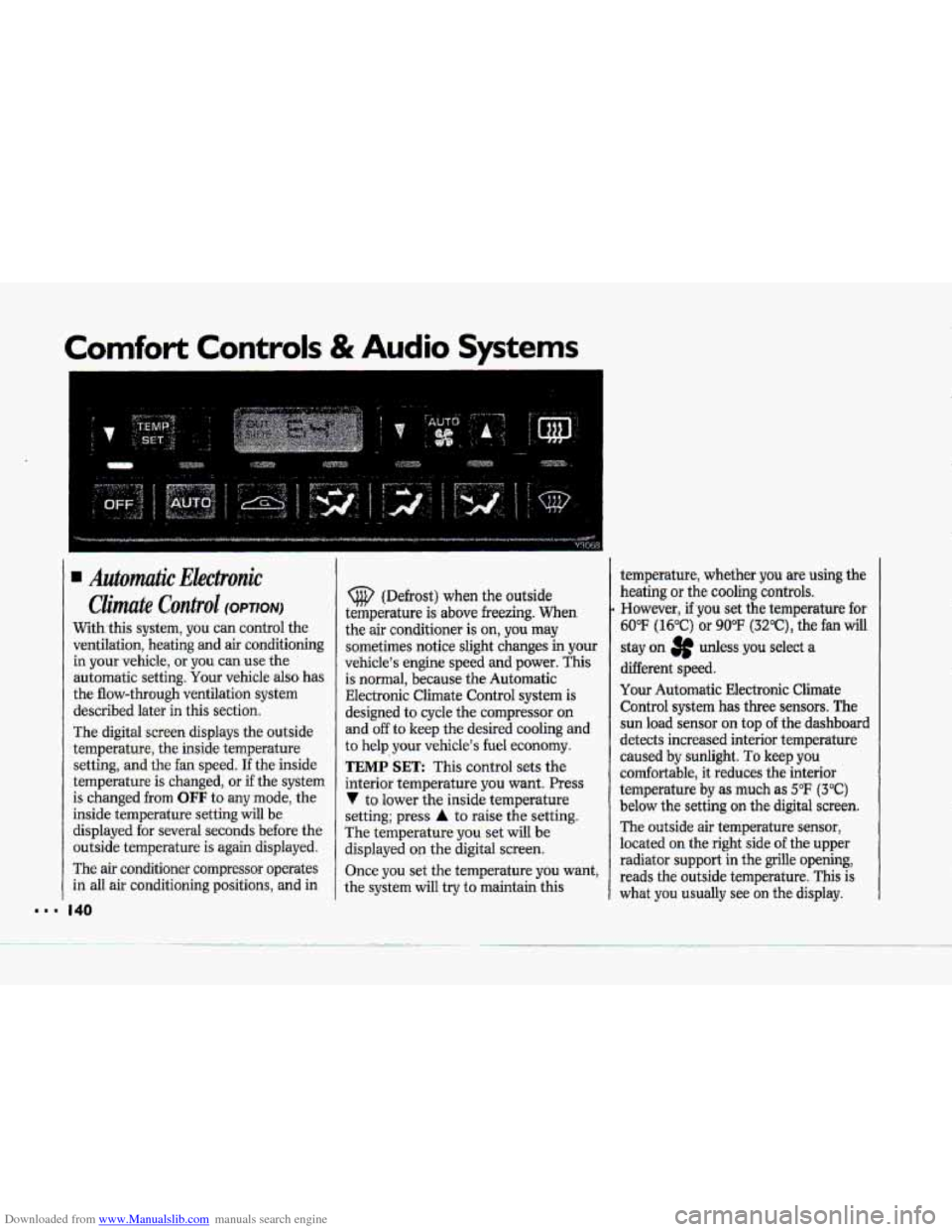
Downloaded from www.Manualslib.com manuals search engine Comfort Controls & Audio Systems
... I..
1. 140
Automutic Ekctronic
Climate Control (OPTION)
With this system, you can control the
ventilation, heating
and air conditioning
in your vehicle, or you can use the
automatic setting.
Your vehicle also has
the flow-through ventilation system
described later
in this section.
The digital screen displays the outside
temperature, the inside temperature
setting, and the fan speed.
If the inside
temperature is changed,
or if the system
is changed from
OFF to any mode, the
inside temperature setting will be
displayed for several seconds before the
outside temperature is again displayed.
The
air conditioner compressor operates
in all air conditioning positions, and in
(@ (Defrost) when the outside
temperature is above freezing.
When
the air conditioner is on, you may
sometimes notice slight changes in your
vehicle's engine speed and power. This
is normal, because the Automatic
EIectronic Climate Control system
is
designed to cycle the compressor on
and off to keep the desired cooling and
to
help your vehicle's fuel economy.
TEMP SET: This control sets the
interior temperature you want. Press
V to lower the inside temperature
setting; press
A to raise the setting.
The temperature
you set will be
displayed on the digital screen.
Once you set the temperature you want,
the system will try to maintain this temperature,
whether
you are using the
heating
or the cooling controls.
However, if you set the temperature for
60°F (16°C) or 90°F (3Z°C), the fan will
stay on 3p udess you select a
different speed.
Your Automatic Electronic Climate
Control system
has three sensors. The
sun load sensor on top of the dashboard
detects increased interior temperature
caused by sunlight.
To keep you
comfortable, it reduces the interior
temperature
by as much as 5°F (3°C)
below the setting on the digital screen.
The outside air temperature sensor,
located on the right
side of the upper
radiator support
in the grille opening,
reads the outside temperature.
This is
what you usually see on the display.
Page 144 of 370
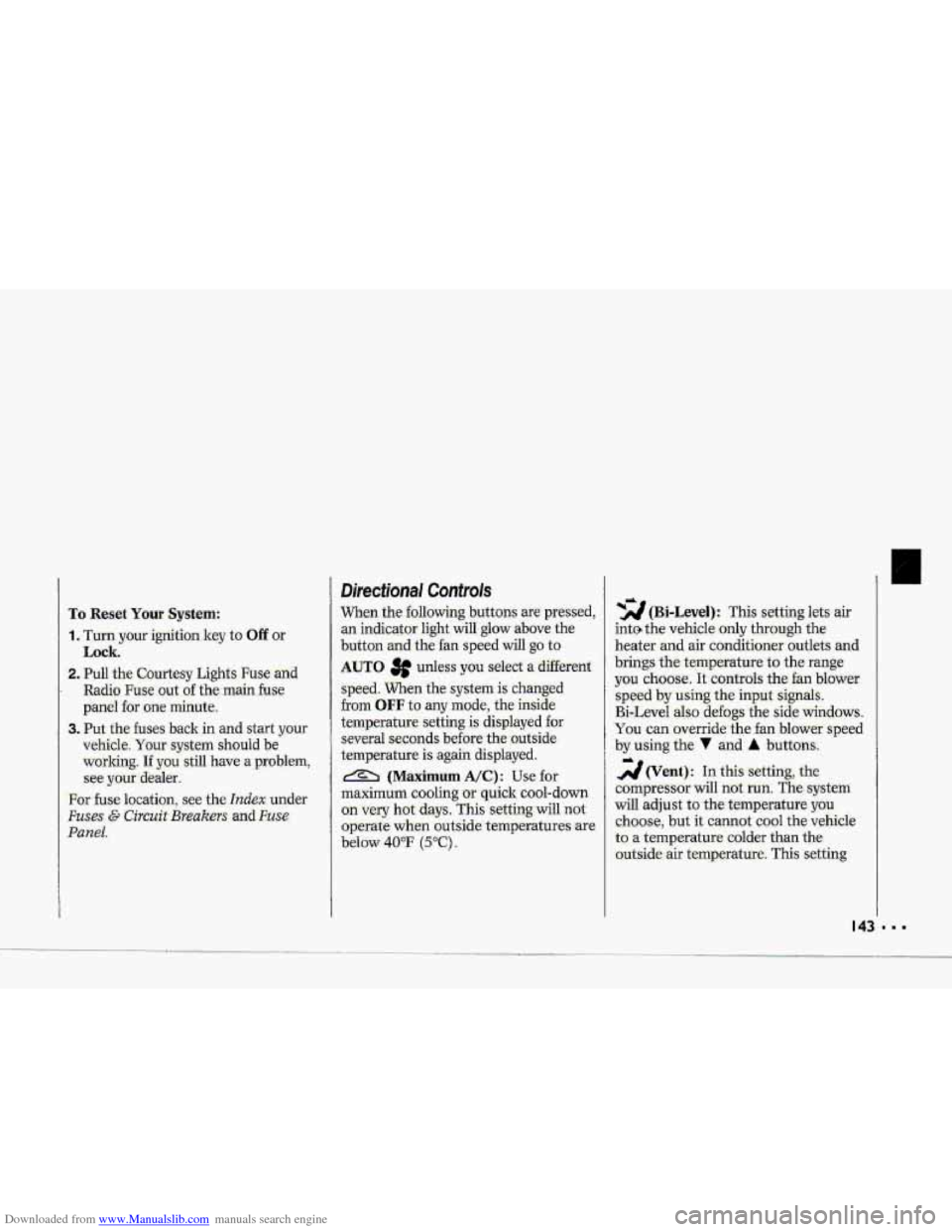
Downloaded from www.Manualslib.com manuals search engine h
P
To Reset Your System:
1. Turn your ignition.lrey to Off or
Lock.
2. Pull the Courtesy Lights Fuse and
Radio Fuse .out of the- main fuse
panel for
one minute.
3. Put-the fuses back in and start your
vehicle. Your system shuuld be
working.
If you still have a problem,
see your deder,
.For
fuse location, see the Index under
Fuses E. CircuitBreakers and Fuse
.Panel.
Directional Controls
When the €allowing buttons are pressed,
an indicator light.
will glow above .the
button and the fan speed will go to
AUTO 3f unless you select a dBerent
speed. When the system is'changed
€rum
OFF tu any mode, the inside
temperature setting is displayed for
several seconds before the .outside
temperature is again displayed.
& (Maximum A/C): Use for
maximum cooling
or quick cool-down
on very hot days..
This setting will not
operate when outside temperatures are
below
40°F (5°C) I
-2 (Bi-Level): This setting lets air
inte the vehicle only through the
.heater and air conditioner outlets and
brings.the temperature
to the range
you choose. It controls the fan blower
speed by using t-he input signals.
Bi-Level al.so
defogs the side windows,
You can. override the,fan blower speed
by using
the V and A buttons.
a(Vent): In this setting, the
compressor
will not. mn. The-system
will adju-st
to the temperature you
choose, but it cannot cool the vehicle
to a temperature colder than the
outside air temperature, This setting
Page 351 of 370
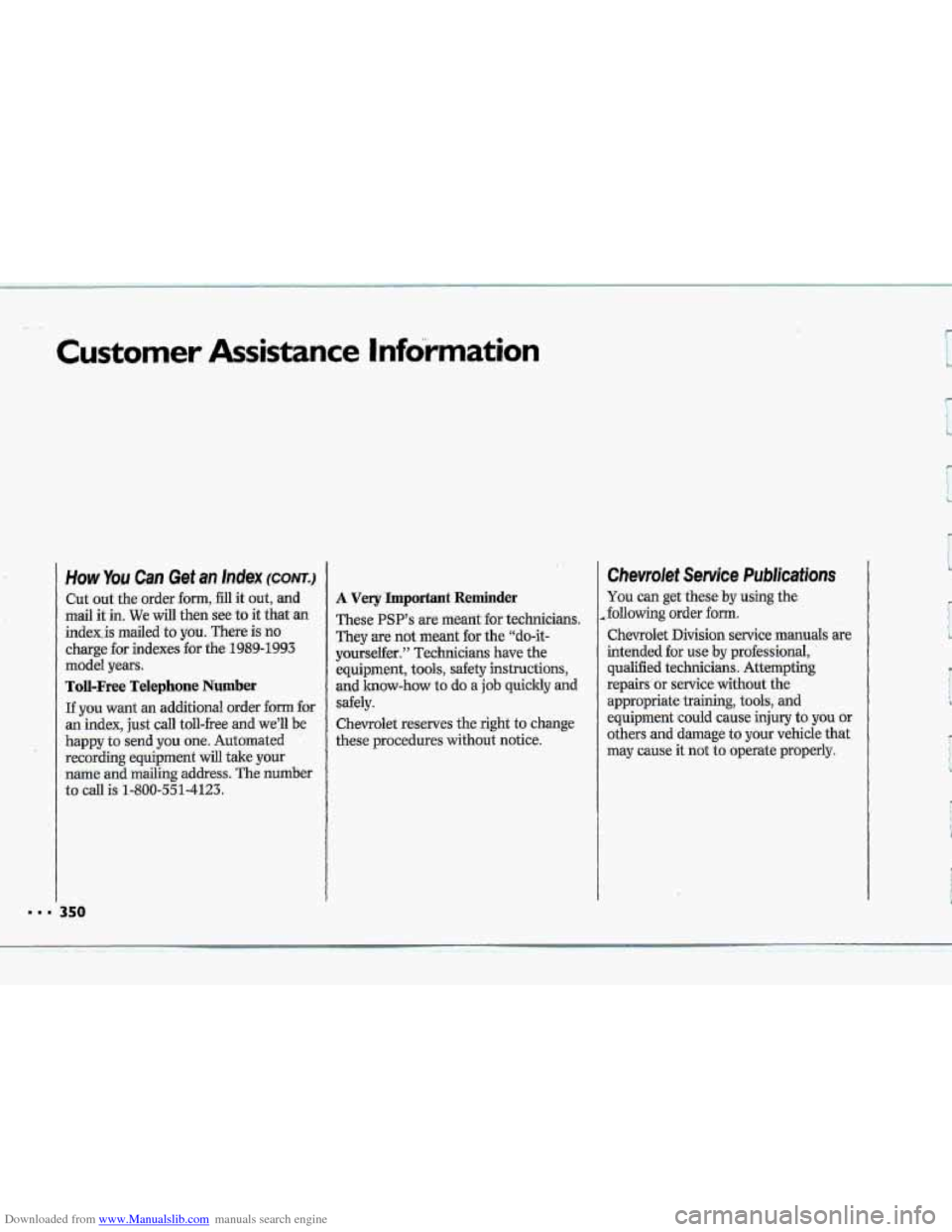
Downloaded from www.Manualslib.com manuals search engine Customer Assistance Information
How Y0.u Can Get an hdex (CONTJ
Cut o.ut theorder fom, fill it out, and
mail it in. We will then see to it that an
index.$ mailed to you. There is no
charge for indexes for the 1989-1993
model yeas.
Toll-Free Telephone Number
If you want an additional order form for
an index, just call toll-free and we31 be
happy to send you one. Automated
recording equipment will take your
name and mailing address. The number
to call is.1-800-551-4123.
’ . 350
I ,.
A-Very Important Reminder
These PSP’s are meant for technicians.
They are not meant for the “do-it-
yourselfer.’’ Technicians have the
equipment, tools, safety instructions,
aid lmaw-how to do a job guicldy and
safely.
Chevrolet reserves the right to change
these procedures without notice.
Chevrolet Service Publications
You can get ‘these by using the
I following order form.
Chevrolet Division service manuals are
intended far use by prdessional,
qualified technicians. Attemptirig
repairs or service without the
appropriate.training,
tools, and
equipment
could cause injury to you or
others and damage to your vehicle that
may cause it not to operate properly.